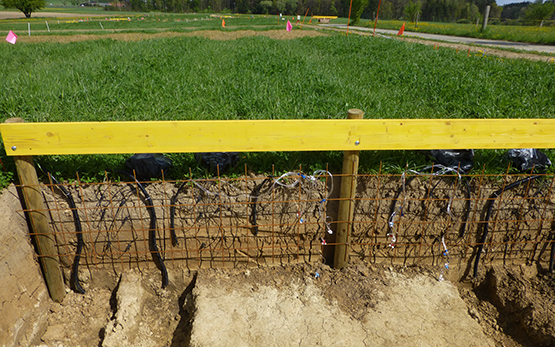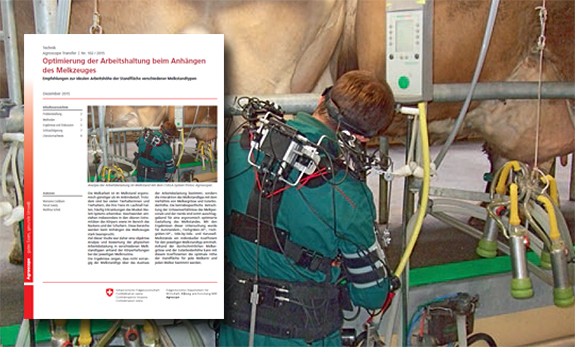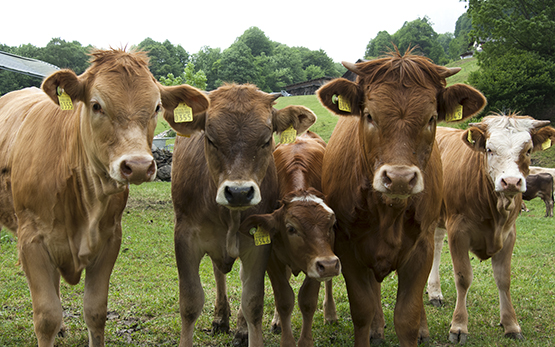Baumgartner S., Spiess E., Liebisch F., Gilgen A.
Regionale Stickstoffbilanzen: Erste Ergebnisse von MAUS (Monitoring des Agrarumweltsystems Schweiz).
Agroscope Science, 185, 2024, 1-43.
Metzger K., Liebisch F., Herrera J. M., Guillaume T., Bragazza L.
Prediction accuracy of soil chemical parameters by field- and laboratory-obtained vis-NIR spectra after external parameter orthogonalization.
Sensors, 24, (11), 2024, 1-17.
Zenkl R., Berlepsch-Valendas A., Liebisch F.
Food for thought: Towards circular nutrient economy in agriculture.
Hrsg. University of Zurich, University of Basel and ETH Zurich, 2024, 7 S.
Piccini C., Metzger K., Debaene G., Stenberg B., Götzinger S., Borůvka L., Sandén T., Bragazza L., Liebisch F.
In‐field soil spectroscopy in Vis–NIR range for fast and reliable soil analysis: A review.
European Journal of Soil Science, 75, (2), 2024, 1-18.
Wiggenhauser M., Illmer D., Spiess E., Holzkaemper A., Prasuhn V., Liebisch F.
Cadmium, zinc, and copper leaching rates determined in large monolith lysimeters.
Science of the Total Environment, 926, 2024, 1-12.
Yuzugullu O., Fajraoui N., Don A., Liebisch F.
Satellite-based soil organic carbon mapping on European soils using available datasets and support sampling.
Science of Remote Sensing, 9, 2024, 1-17.
Jordan-Meille L., Denoroy P., Dittert K., Cugnon T., Quemada M., Wall D., Bechini L., Marx S., Oenema O., Reijneveld A., Liebisch F., Diedhiou K., Degan F., Higgins S.
Comparison of nitrogen fertilisation recommendations of West European countries.
European Journal of Soil Science, 74, (6), 2024, 1-38.
Neuweiler R., Huguenin-Elie O., Schöneberg T., Guillaume T., Liebisch F.
Nmin-Methode für die Düngebedarfsermittlung.
Hrsg. Agroscope, Merkblatt Nr. 194, 2023, 4 S.
weitere Sprachen: französisch | italienisch
Guillaume T., Carlen C., Gilgen A., Liebisch F.
Düngebedarfsermittlung nach korrigierten Normen.
Hrsg. Agroscope, Merkblatt Nr. 201, 2023, 4 S.
weitere Sprachen: französisch | italienisch
Schöneberg T., Liebisch F.
Düngung im Gemüsebau: Grundlagen für die Düngung landwirtschaftlicher Kulturen in der Schweiz (GRUD 2023) – Kapitel 10.
Hrsg. Agroscope, 2023, 25 S.
weitere Sprachen: französisch | italienisch
Higgins S., Keesstra S. D., Kadziuliene Z., Jordan-Meille L., Wall D., Trinchera A., Spiegel H., Sanden T., Baumgarten A., Jensen J. L., Hirte J., Liebisch F., Klages S., et al.
Stocktake study of current fertilisation recommendations across Europe and discussion towards a more harmonised approach.
European Journal of Soil Science, 74, (5), 2023.
Bernert G., Liebisch F.
Stickstoff-Injektionsdüngung mit CULTAN.
Hrsg. Agroscope, Merkblatt Nr. 190, 2023, 4 S.
weitere Sprachen: französisch | italienisch
Lorenzetti R., Castaldi F., Fondon C.L., Boruvka L., Metzger K., Ben-Dor E., Egmond van E., Barbetti R., Fantappie M., Debaene G., Klumpp K., Liebisch F., Gholizadeh A., Stenberg B., Knadel M.
The contribution of the European Project Probefield to in-field use of proximal soil sensors.
In: 2023 IEEE International Workshop on Metrology for Agriculture and Forestry. 6-8 November, Pisa. 2023.
Bernert G., Spiess E., Liebisch F.
CULTAN-Düngung reduziert die Stickstoffauswaschung bei gleichbleibendem Ertrag.
Agrarforschung Schweiz, 14, 2023, 207-213.
weitere Sprachen: französisch
Spiess E., Liebisch F.
Nährstoffbilanz der schweizerischen Landwirtschaft für die Jahre 1975 bis 2021.
Agroscope Science, 170, 2023, 1-22.
Argento F., Bischoff W. A., Liebisch F.
Balancing carbon storage and groundwater quality in crop production in Switzerland.
In: European Healthy Soil Conference - 1st Edition: Soil Fertility. 14 September, Hrsg. FHNW School of Life Sciences / Agroscope, Muttenz. 2023, 1.
Nucera E., Huguenin-Elie O., Mayer J., Liebisch F., Spiess E.
Method for estimating nitrogen input by symbiotic fixation on Swiss farms.
Agroscope Science, 164, 2023, 1-49.
Metzger K., Liebisch F., Herrera J. M., Guillaume T., Walder F., Bragazza L.
The use of visible and near-infrared spectroscopy for in-situ characterization of agricultural soil fertility: A proposition of best practice by comparing scanning positions and spectrometers.
Soil Use and Management, In Press, 2023, 1-13.
Thiébaud E., Hafner D., Huber S., Giuliani G. , Meier T., Ringger C., Stüssi M., Liebisch F., Leifeld J., Oberholzer H., Kreft C., Huber R., Finger R., Bertschi M., Meili J. und weitere
CO2-Endbericht Ressourcenprojekt "AgroCO2ncept Flaachtal".
Hrsg. dss+ und Flury&Giuliani GmbH, 22. Mai, 2023, 125 S.
Hirte J., Liebisch F.
Crop response to soil potassium under diverse pedoclimatic conditions in multiple environments: Implications for fertilization recommendations.
In: Long Term Experiments: Meeting future challenges. 22 June, Rothamsted. 2023, 1-18.








